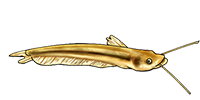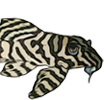In Tanganyika C*****ds in their natural habitat by Ad Konings, there is a photo labelled S.Nigromaculatus on page 248. It appears to be different from the individuals in the cat-e-log & other info sources - more distinct pattern etc although the specimen is not in an ideal orientation. Is this a correct ID or something else?
I'd like some opinions, if anyone has any. Cheers
Richard B
S.Nigromaculatus (Konings: Tang C*****ds)
- Richard B
- Posts: 6952
- Joined: 11 Aug 2006, 13:19
- I've donated: $20.00!
- My articles: 9
- My images: 11
- My cats species list: 37 (i:0, k:0)
- My aquaria list: 4 (i:0)
- My BLogs: 2 (i:0, p:29)
- Spotted: 10
- Location 1: on the sofa, or maybe at work?
- Location 2: Warwickshire: UK
- Interests: Tanganyika Catfish, African catfish, Non-loricariid sucker-catfish.
Running, drinking, eating, sci-fi, stapelids
- sidguppy
- Posts: 3827
- Joined: 18 Jan 2004, 12:26
- My articles: 1
- My images: 28
- My aquaria list: 5 (i:0)
- Spotted: 9
- Location 1: Southern Netherlands near Belgium
- Location 2: Noord Brabant, Netherlands
- Interests: African catfishes and oddballs, Madagascar cichlids; stoner doom and heavy rock; old school choppers and riding them, fantasy novels, travelling and diving in the tropics and all things nature.
- Contact:
Konings is a cichlid-man, the captions on the pics with eels and catfishes are mostly wrong.
in the first edition of Back to Nature S multipunctatus and S petricola are mixed up, but it's not that hard to see wich is wich.....
on page 248 there are 2 Syno's labelled incorrect:
nr 6 is not a S dhonti but a S petricola; S dhonti has a black dorsal spine, not white.
and the fish in pic 7 is one of those S polli related fishes; the heavy build, small coppery eye, huge upper lip and short thin barbels all point at S polli. the markings are weird, but remember that juvenile polli's are highly contrasting black and white fishes with beautiful vermiculated pattern on the body.
adults are brown fishes with darker brown spots. this one looks like it's right in the middle of that transition.
S nigromaculatus has a bodyshape not un like S njassae; it's streamlined with a pointy snout, a narrow mouth, long whiskers, big eyes, big fins. your typical riverine fast moving Syno'.
not like the stubby heavybuilt rubberlipped small-eyed syno's from the S dhonti-polli-petricola-tanganicae-group.
in the first edition of Back to Nature S multipunctatus and S petricola are mixed up, but it's not that hard to see wich is wich.....
on page 248 there are 2 Syno's labelled incorrect:
nr 6 is not a S dhonti but a S petricola; S dhonti has a black dorsal spine, not white.
and the fish in pic 7 is one of those S polli related fishes; the heavy build, small coppery eye, huge upper lip and short thin barbels all point at S polli. the markings are weird, but remember that juvenile polli's are highly contrasting black and white fishes with beautiful vermiculated pattern on the body.
adults are brown fishes with darker brown spots. this one looks like it's right in the middle of that transition.
S nigromaculatus has a bodyshape not un like S njassae; it's streamlined with a pointy snout, a narrow mouth, long whiskers, big eyes, big fins. your typical riverine fast moving Syno'.
not like the stubby heavybuilt rubberlipped small-eyed syno's from the S dhonti-polli-petricola-tanganicae-group.
Valar Morghulis
- sidguppy
- Posts: 3827
- Joined: 18 Jan 2004, 12:26
- My articles: 1
- My images: 28
- My aquaria list: 5 (i:0)
- Spotted: 9
- Location 1: Southern Netherlands near Belgium
- Location 2: Noord Brabant, Netherlands
- Interests: African catfishes and oddballs, Madagascar cichlids; stoner doom and heavy rock; old school choppers and riding them, fantasy novels, travelling and diving in the tropics and all things nature.
- Contact:




